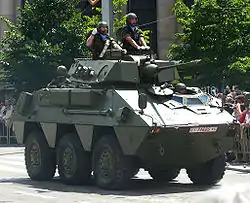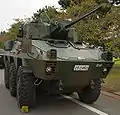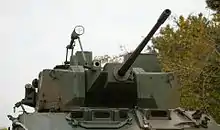Type 87 ARV
The Type 87 Reconnaissance and Patrol Vehicle, also known as Burakkuai (Romaji for "black eye") or Type 87 ARV (for Armored Reconnaissance Vehicle) for short, is a 6x6 wheeled Armoured Fighting Vehicle designed and manufactured by multinational heavy industry manufacturer Komatsu Limited and employed exclusively by the Japanese Ground Self-Defense Forces. The JGSDF continued to commission new units up until as recently as 2013[3]
| Komatsu Type 87 ARV | |
|---|---|
 The Type 87 on display at Camp Takeyama. | |
| Type | Armoured Fighting Vehicle |
| Place of origin | Japan |
| Service history | |
| In service | 1987 - present |
| Used by | Japanese Ground Self-Defense Forces |
| Production history | |
| Designed | 1983 |
| Manufacturer | Komatsu |
| Unit cost | 2,5 million yen |
| Produced | 1987 |
| Specifications | |
| Mass | 15 tonnes |
| Length | 5.99 m |
| Width | 2.48m |
| Height | 2.8m |
| Crew | 5 (driver, radio operator, gunner, observer and commander) |
| Armor | 8mm Rolled homogeneous armour[1] |
Main armament | 25mm Oerlikon Autocannon |
Secondary armament | Type 74 7.62mm Machinegun |
| Engine | Isuzu 10PBI diesel engine 305 hp / 2,700 rpm[2] |
| Suspension | coil springs |
| Ground clearance | 1.5 m |
Operational range | 500 km |
| Maximum speed | 100 km/h |
History
After World War II, the United States provided the newly-created Japanese Ground Self-Defense Forces with a number of variants of the M8 Greyhound armoured car. However, a relatively small number of these were employed due to concerns about the poor quality of roads in Japan, as many Japanese roads were unpaved and poorly maintained, limiting the feasibility of wheeled vehicles for military service. By 1982, Japanese infrastructure had greatly improved, motivating the development of the first armoured fighting vehicle developed and manufactured by Japanese industry for the Japanese armed forces, the successful Type 82 'Shikitsu' Command Vehicle. Tests for the Type 87 began in 1985 and the Type 87 would later finish developed by Komatsu based on the earlier Type 82.
Features
The Type 87 features the same kind of hull construction that is common for armored military vehicles, where the armoured exterior of the vehicle acts both as protection and as the main structural framework, as opposed to the chasis-and-coachwork structure that is typical of civilian and non-armored construction. Its rectangular body is sloped in the front and accommodates five crew members, two of which occupy the powered-traverse turret located in the center of the hull. The vehicle's door is on the left of the main body.
The Type 87's hull is made out of steel and is fully welded, and utilizes many of the same automotive components of the Type 82 and features power steering. The main armament is a Japanese version of the Oerlikon Contraves 25 millimeter autocannon produced under licence, which can fire various kinds of ammunition at up to 600 rounds per minute. Its armor, while sturdy enough to protect the vehicle and crew against small arms fire and grenade shrapnel, will not protect against heavier ordnance. It is well armed for its class but lacks truly amphibious capabilities, being only able to ford up to 1.5 metres (4.9 ft) of water.
| portrait |  |
 |
 |
 |
|---|---|---|---|---|
| Length | 5.99m | 5.75m | 6.2m | 7.74m |
| Width | 2.48m | 2.35m | 2.5m | 2.98m |
| height | 2.80m | 2.31m | 2.51m | 2.84m |
| mass | 15.0t | 7.7t | 13.75t | 19.5t |
| top speed | 100 km/h | 100 km/h | 99 km/h | 90 km/h |
| amphibious? | no | yes | yes | yes |
| crew | 5 | 4 | 5 | 4 |
| Weapons | 25mm Oerlikon auto-cannon Type 74 7.62mm machine-gun |
KPV 14.5mm heavy machine gun×1 PKT 7.62mm machine-gun |
M242 auto-cannon MG3 7.62mm machine-gun |
Rheinmetal MK20 auto-cannon MG3 7.62mm machine-gun |
Gallery
References
- "Type 87 AFV". www.tanks-encyclopedia.com.
- ARG. "Type 87 Armored Reconnaissance Vehicle - Military-Today.com". www.military-today.com.
- "防衛省・自衛隊:予算等の概要". www.mod.go.jp.
- Chant, Christopher (1987). A Compendium of Armaments and Military Hardware. Routledge.
External links
| Wikimedia Commons has media related to JGSDF Type 87 Reconnaissance Vehicle. |




